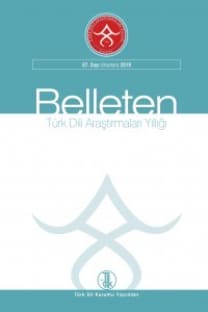GAZAVAT-NÂME-İ MİDİLLİ TÜRK DİLİ VE KÜLTÜR TARİHİ BAKIMINDAN DEĞERİ
Gazavat-nâmeler savaşları anlatan edebî türlerdir. Edebî bakımdan önem taşıdıkları
Anahtar Kelimeler:
gazavat-nâme, mesnevî, şiir, tarih
GAZAVAT-NÂME-İ MİDİLLİ TÜRK DİLİ VE KÜLTÜR TARİHİ BAKIMINDAN DEĞERİ
Gazavat-nâmes are the literary works that tell about wars. Apart from having literaryimportance it also carries historical and cultural importance. At the time it was written they intend to make people aware of culture and literature. During 15thcentury, this gazavat-name literal work was taken into account by Gubârî, its turkishstyle with its cultural history was carefully examined. While the war was going onin Midili Island in most places, doubtless there were hails from an abstract mysticalworld, despite this style of the poet, This literal work didn’t lose it cultural and literalaspects. First of all, this text carries the history of Turkish language and its an importantsource too since it contain much terminology of the old Anatolian Turkish,closeto this it also contain important information about the Turkish history.Some refer thiswork as a source of series of fact event that are explained in some history books.At thetime it was taken it intended to reflect social structure, cultural elements,ideologicalaspects and life aspects as a whole,due to this it is considered as an important culturalhistory book.
Keywords:
gazavat-nâme, mesnevî, poem, history,
___
- Akdağ , Mustafa (1995), Türkiye’nin İktisadî ve İçtimaî Tarihi, C. I, İstanbul.
- Alparslan Ali (1996), “Gubârî Abdurrahman”, TDV İslam Ansiklopedisi,C. 14, İstanbul.
- Canım , Rıdvan (2000), Latîfî Tezkiretü’-Şu’arâ ve Tabsıratu’n-Nuzamâ, Ankara.
- Danişmend , İsmail Hâmi (1947), İzahlı Osmanlı Tarihi Kronolojisi, İstanbul.
- Horata , Osman (1988), “Ses, Anlam Bütünlüğü ve Gazel-i Tecnisler”,
- Doğu Akdeniz Türk Dili ve Edebiyatı Bölümü Dergisi, S. I, s. 65-75, Kıbrıs.
- Köprülü , Fuad (1999), Edebiyat Araştırmaları, “Türk Aruzu”, s. 338-360,Ankara.
- Levend , Agah Sırrı (2000), Gazavât-Nâmeler, Ankara.
- Mehmed Süreyya (1996), Sicil-i Osmânî, (Hzl. A. Aktan-A. Yuvalı-M. Hülagu),İstanbul.
- Özmen , Mehmet (2001), Ahmed-i Dâî Divanı (Metin-Gramer-Tıpkıbasım),C.I, Ankara.
- Parmaksızoğlu İ. (Vd.) (1980), Firdevsî-i Rumî/Kutb-Nâme, Ankara.
- Şemseddin Sami (1996), Kâmusu’l-A’lâm, C. 5, Kaşgar, Ankara.
- ISSN: 0564-5050
- Başlangıç: 1953
- Yayıncı: Türk Dil Kurumu
Sayıdaki Diğer Makaleler
TÜRKMEN VE TÜRKİYE TÜRKÇESİNİN KESMEKLE İLGİLİ ORTAK FİİLLERİNİN ANLAM FARKLILIKLARI ÜZERİNE
GAZAVAT-NÂME-İ MİDİLLİ TÜRK DİLİ VE KÜLTÜR TARİHİ BAKIMINDAN DEĞERİ
DİLİN ETİK YAPILANMASI VE AHLAKİ İŞLEVİ
NECATİ CUMALI’NIN “BOZKIRDA BİR ATLI” ŞİİR KİTABININ DİL VE ÜSLUBU ÜZERİNE
Davranışsal Dil Bilimine Kısa Bir Bakış: L. Bloomfield ve B. F. Skinner Yaklaşımları
K. K. Yudahin Sözlüğüne Göre Kırgızca Söz Varlığı
YAZICIZADE AHMED BÎCAN’IN DÜRR-İ MEKNÛN ADLI ESERİ ÜZERİNE
